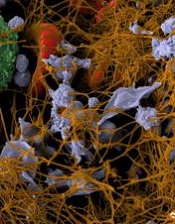
Image by Andre E.X. Brown
The platelet protein RASA3 is critical to treatment success with the antiplatelet drug clopidogrel (Plavix), according to research published in The Journal of Clinical Investigation.
The study shows that RASA3 is part of a cellular pathway that is crucial for platelet activity during thrombus formation.
Researchers believe this newfound information could aid the development of new antiplatelet compounds and antidotes to clopidogrel.
“We believe these findings could lead to improved strategies for treatment following a heart attack and a better understanding of why people respond differently to antiplatelet drugs such as aspirin and Plavix,” said study author Wolfgang Bergmeier, PhD, of the University of North Carolina at Chapel Hill.
Since the 1970s, scientists have known that clopidogrel has an anticlotting effect on platelets. In 2001, they found the compound’s target—the adenosine diphosphate receptor P2Y12. But they didn’t know how this receptor communicates with other proteins in the cell pathways important for platelet activation.
Researchers have since learned that P2Y12 communicates with RAP1, a small GTPase that cycles between an inactive GDP-bound form and an active GTP-bound form. RAP1 is tightly regulated by GEFs, which stimulate GTP loading, and GAPs, which catalyze GTP hydrolysis.
Dr Bergmeier’s group and others previously showed that RAP1 regulates platelet adhesion and thrombosis.
Now, his team has found evidence suggesting the GAP RASA3 is the “missing link” between P2Y12 and RAP1 in platelets. And agents that inhibit P2Y12, like clopidogrel, prevent thrombosis mainly through their effect on RASA3/RAP1 signaling.
The researchers used deep sequencing techniques to show that RASA3 was the only highly expressed GAP gene for RAP1 in platelets. And they hypothesized that a malfunctioning RASA3 protein would lead to the activation and clearance of platelets.
Experiments showed that mice with a RASA3 mutation had 3% to 5% of the typical platelet count. The rest of their platelets were being activated and cleared from circulation.
However, when the researchers disabled the major GEF proteins, platelet counts rose to normal levels. This suggests a tightly controlled balance between GEF and GAP proteins, especially RASA3, is vital for platelet activity.
“These experiments show that this RAP1 GEF-GAP pathway is crucial for platelets to jump into action to plug a hole in the endothelium,” Dr Bergmeier said. “And now we know that RASA3 is a critical negative regulator, a ‘brake’ on the process.”
“We have good reason to believe that the RAP1 ‘switch,’ controlled by the same GEF and GAP proteins, also regulates the active state of human platelets. We expect this research will provide critical information for improving antiplatelet therapies, possibly including approaches that eliminate some of the patient-to-patient variability and the increased bleeding risk associated with current antiplatelet drugs.”


